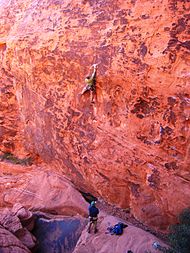
Back Toprope German Moulinette Spanish Moulinette (escalade) French טיפוס TopRope HE Moulinette Italian Topropen Dutch Asekuracja na wędkę Polish Top-rope Portuguese
| Part of a series on |
| Climbing |
|---|
 |
| Lists |
| Types of rock climbing |
| Types of mountaineering |
| Other types |
| Key actions |
| Key terms |
Top rope climbing (or top roping) is a form of rock climbing where the climber is securely attached to a climbing rope that runs through a fixed anchor at the top of the climbing route, and back down to the belayer (or "second") at the base of the climb. A climber who falls will just hang from the rope at the point of the fall, and can then either resume their climb or have the belayer lower them down in a controlled manner to the base of the climb. Climbers on indoor climbing walls can use mechanical auto belay devices to top rope alone.
By definition, top roping can only be done on routes that are less than half the length of a typical climbing rope, which means single-pitch routes that are below 25–30 metres (82–98 ft) in height. Top roping is also used in ice climbing, and the related sports of mixed climbing and dry-tooling, and it is used in combination with auto belay devices in both competition speed climbing and competition ice climbing.
Top roping is one of the relatively safest forms of rock climbing and is used by most beginners and novices of the sport. Before the era of sport climbing, top roping a route for practice (known as headpointing or hangdogging) was considered poor practice; however, it is now a legitimate technique in preparing for a redpoint ascent. Top roping a new route is not considered a first free ascent of a climb, and because of the ability of the belayer to give aid to the climber, it is not strictly free climbing (although some advocate that with slack, it is similar to free climbing), and is thus differentiated from 'normal' lead climbing.
© MMXXIII Rich X Search. We shall prevail. All rights reserved. Rich X Search